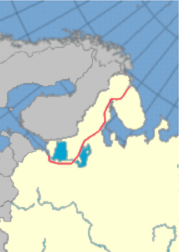Company keystone
The Schlussstein operation was a German operation that was only just beginning to be carried out towards the end of the First World War in the Baltic Sea region and Karelia with the aim of occupying the Murman Railway .
prehistory
After the victory of the Bolsheviks in the October Revolution at the end of 1917, the unstable Russian situation caused by the civil war prompted the German Supreme Army Command to proceed expansively in the east. The peace treaty of Brest-Litovsk in the spring of 1918 seemed to end the war in the east, but there was still no peace due to the civil war situation. The non-Russian peoples had been granted sovereignty by Lenin , but fighting broke out in these areas, especially in Finland and Ukraine , with the Bolsheviks trying to export the revolution and establish socialist regimes there.
Germany used this fact, which represented a breach of the Brest-Litovsk peace treaty, as a pretext for further conquest. Political expansion intentions and actual security concerns of the military regarding military intervention on the part of the Entente and the establishment of pro-German, predictable governments instead of unleashed revolutionary fury in the affected areas cannot be clearly distinguished. The political goals on the German side were very heterogeneous - but the military reasons were in the foreground. In this context, the Åland Islands were occupied in March and in April 1918 they intervened in the Finnish Civil War , the so-called Finland Intervention . The German side was unclear about how to proceed and several scenarios were discussed between the Supreme Army Command and the Foreign Office .
At the same time as the German expansion into the northern Baltic Sea, British and French troops landed in Murmansk in order to protect their supplies for the Russian army from looting or conquest by the Red Army , if necessary to advance via the Murman Railway and on the side of the White Army in to intervene in the fighting against Bolsheviks and German troops.
German considerations
In the summer of 1918 the victory of the Bolsheviks seemed questionable after several violent setbacks. The German military attaché in Moscow, Wilhelm Schubert, recommended joining the anti-Bolshevik forces. The State Secretary of the Foreign Office, Rear Admiral a. D. Paul von Hintze , vehemently and advocated a joint approach with the Soviets. On the German side, for example, there is a very mixed picture of conflicting interests regarding future action.
Soviet ideas
In view of further imminent Allied landings, the Bolshevik side advocated joint action against the Murman Railway, white associations in the Ukraine (especially the Don Cossacks ) and against General Alexejew . The latter was again rejected by the German side.
German planning
A prerequisite for the action against the Murman Railway was the approval of the Bolsheviks to occupy Kronstadt and Petrograd , which was ultimately accepted. On the German side, they wanted to secure a logistical base on the one hand due to the well-developed railway network there, but at the same time gain control over the Baltic fleet and the center of power in Russia.
Vice-Admiral Friedrich Boedicker was appointed commander of the German forces and immediately cleared the access routes from mines to the Gulf of Finland. The following units and units should be deployed by the Imperial Navy :
- Liner ships: East Frisia , Thuringia , Nassau
- IV. Reconnaissance group with the small cruisers: Regensburg , Frankfurt , Stralsund , Strasbourg
- Small cruiser Kolberg
- Aviso / Tender Blitz
- V. Torpedo boat flotilla with the large torpedo boats V 1 , V 2 , V 3 , V 5 , V 6 , G 7 , G 8 , G 10 , G 11 , S 23
- Aircraft mother ship SMH Answald
course
From August 12, 1918, mine clearing in the Gulf of Finland began. The ships of the line remained on standby in Kiel . The staff of the 1st Squadron, to which the ships of the line belonged, embarked on the small cruiser Stralsund on August 16 and drove to Libau , where Commander Boedicker boarded. The ship moved to Björkö Sund via Reval , Helsingfors , Narwa and Hungerburg . Then the company was postponed for the time being due to the unclear situation on the Eastern Front. On September 9th, SMS Stralsund relocated back, this time to Wilhelmshaven and disembarked the staff again, only to return immediately to Björkö on September 16th. The ship was replaced on September 27th by the old coast tank Beowulf , which remained there as a stationary.
On September 27, the company was given up due to the general military and political situation. The cause of the situation in the Balkans and the collapse of the Macedonia front led to the suspension of all offensive operations in the Baltic Sea region and on the eastern front.
literature
- Winfried Baumgart : Enterprise Keystone. On the military-political history of the First World War. In: Wehrwissenschaftliche Rundschau 19, vol. 1–7. ES Mittler & Sohn, Frankfurt / M. 1969. Digitized: [1]
- Heinrich von Gagern: The War at Sea 1914-1918. The war in the Baltic Sea. Vol. III From the beginning of 1916 until the end of the war . Frankfurt / Main 1964
- Hans H. Hildebrandt, Albert Röhr, Hans Otto Steinmetz: The German warships. Vol. 1 . Herford 1993
- Walter Hubatsch : The Imperial Navy . Munich 1975
- Gerhard Koop, Klaus-Peter Schmolke: Small cruisers 1903 - 1918. Bremen to Cologne class . Bernard & Graefe, Bonn 2004
